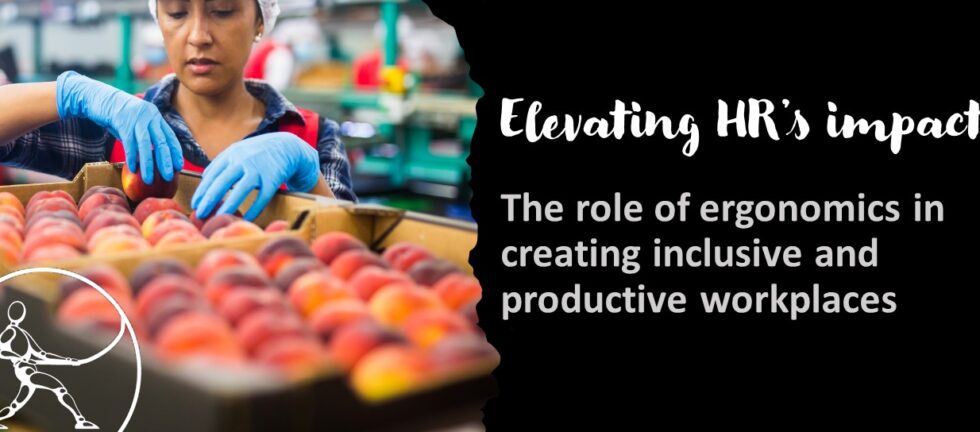Ergonomics is involved in injury prevention (aka safety); to the extent that the ergonomist is involved in assessing injury risk and recommending corrective actions, the role is safety-oriented. Beyond safety initiatives, ergonomics is also involved in accommodating workers with limitations, in ensuring inclusive, equitable workplaces, and in developing strategies and policies that optimize employee engagement, productivity, and quality. Let’s explore these aspects of ergonomics. In this article, we delve into the multifaceted aspects of ergonomics that can significantly enhance HR’s effectiveness.
Accommodation
Workers may present physical or cognitive limitations associated with work-related, or non-work-related injuries, illnesses, and conditions. While the safety department traditionally reacts only to work-related safety issues, HR considers the whole worker. An ergonomist can help to suggest accommodations for workers with cognitive disabilities, or broken limbs, or heart conditions. If your ergonomist is only involved with accommodating strain/sprain injuries, you’re missing out on full use of this person’s skillset.
Diversity, Equity, and Inclusivity (DEI)
An ergonomist is trained to encourage the development of jobs that accommodate everyone. This, by definition, is “inclusion”. Invite an ergonomist to the table when discussing DEI initiatives. For example:
- Are your workstations chosen or designed to accommodate everyone in your workforce?
- Do you choose chairs that accommodate most people, and provide support to the few that are not accommodated with your standard chair.
- Have you confirmed that all of your personal protective equipment (gloves, coveralls, glasses, hearing protection, etc.) is provided in a range of sizes that will accommodate everyone in your workplace?
- If you are expanding your hiring practices to encourage diversity, have you made the corresponding changes in the workplace to accommodate the wider range of capabilities that these new employees will present?
- If you are encouraging employees to consider positions that have traditionally been filled by a particular population, have you provided clear information about the demands of these positions? A quantitative physical and cognitive demands analysis, with photographs, can help employees to understand what they would be getting into.
Employee engagement, productivity, and quality
Human Resources folks help an organization get the most out of its employees. Employees who are “engaged” miss less work (less absenteeism), and stay with the same employer for longer (less turnover). Employees who are comfortable in their jobs are more engaged.
Not convinced? Try this: Perch on the edge of your chair. Now work like that for at least 2 hours, and consider how you feel about your job. Remember those ads that said, “If you can’t breathe, nothing else matters”? Similarly, if your back hurts, you won’t be able to apply the same “focus” on your work, and you’ll start casting around for something else to do.
Productivity and quality follow the same principles. If employees are comfortable in their work, they can work faster or more efficiently, and they make fewer mistakes.
- Call center employees who have the option to sit or stand are probably not as crabby to their customers. (I always ask, when I’m on the phone with a customer service rep, what kind of furniture they have.)
- Inspectors who have to bend or squat to identify quality defects are going to miss more defects than you’d like.
- Employees who have to exert near-maximal efforts to fit two parts together are going to cause more re-work at the end of the day.
When employees are struggling to keep up, or to produce good quality work, eventually the supervisor will trudge into HR for some support. If the HR department can send an ergonomist to study the job and suggest improvements, the job can be designed for the workers. The organization can therefore optimize the use of their most valuable resources: their humans.
Wouldn’t it be nice if ergonomics could get involved before the supervisor reaches the end of the proverbial rope? Before injuries occur? Before the cost of scrap and re-work threatens the viability of a process? An effective HR department looks for opportunities to apply ergonomics with the goal of improving the fit between workers and jobs. Safety, productivity, quality, and engagement benefits will surely follow.
Recognizing and embracing ergonomics as an integral part of HR’s strategy can revolutionize the workplace. Beyond safety concerns, ergonomics becomes a catalyst for diversity, equity, and inclusivity while fostering employee engagement, productivity, and quality. As HR leaders, integrating proactive ergonomics practices ensures a workforce that thrives, setting the stage for sustained success and growth.


